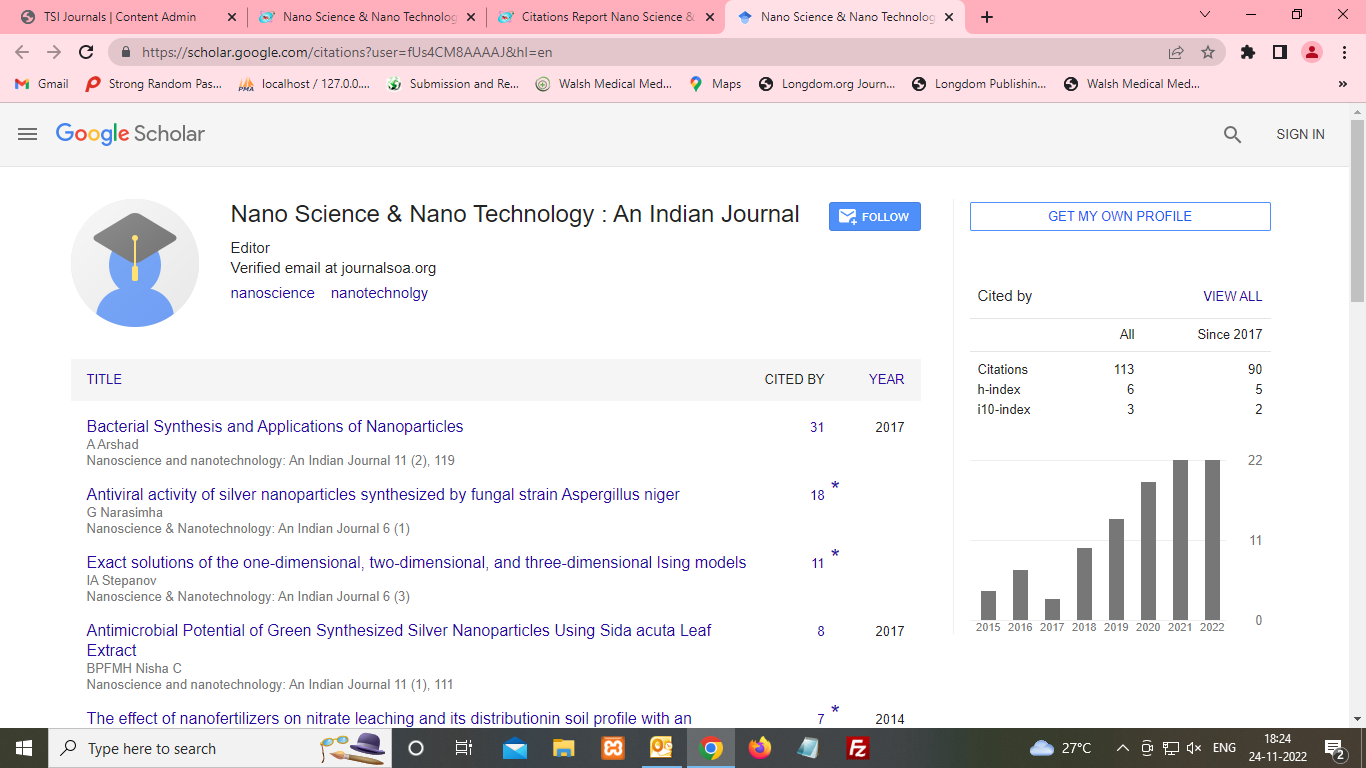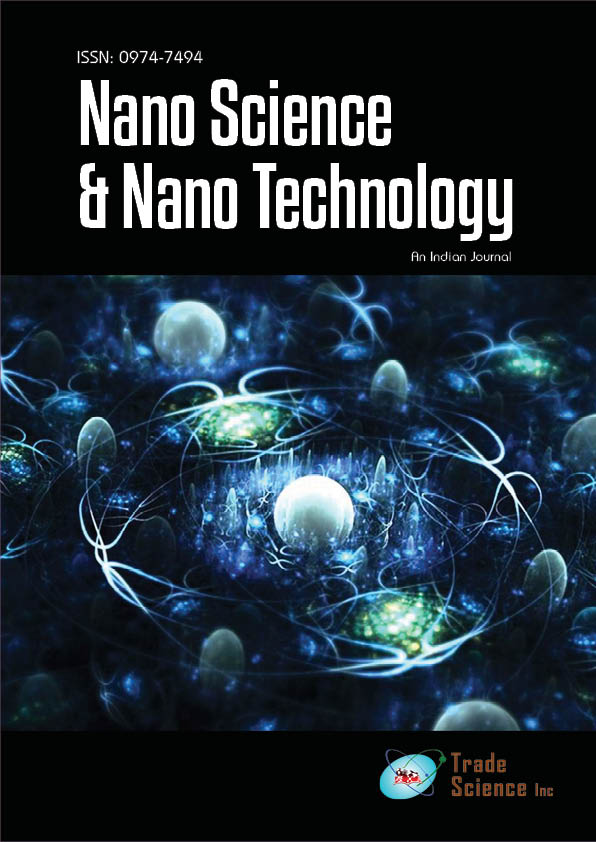Viewpoint
, Volume: 16( 1) DOI: 10.37532/ 0974-7419.2022.16(1)Opportunities, Toxicological Implications, and Occupational Dangers of Nanotechnology In Agriculture
- *Correspondence:
- Steff Brown Editorial office, Nanoscience & nanotechnology: An Indian Journal, UK. ; E-mail: info@tsijournals.com
Citation: Steff Brown. Opportunities, Toxicological Implications, and Occupational Dangers of Nanotechnology In Agriculture. Nano Tech Nano Sci Ind J. 2022;16(1):144.
Abstract
Urbanization, energy and resource limits, sustainable resource use, runoff, and pesticide and fertilizer buildup are some of the agricultural and environmental concerns that nanotechnology has the ability to address. Because of the increased desire for improved agricultural yields and more effective techniques to enhance agricultural operations, the usage of nano scale materials in agricultural research is expanding. In reality, nanotechnology may have a significant influence on the development of sustainable agriculture and precision farming.Introduction
Urbanization, energy and resource limits, sustainable resource use, runoff, and pesticide and fertilizer buildup are some of the agricultural and environmental concerns that nanotechnology has the ability to address. Because of the increased desire for improved agricultural yields and more effective techniques to enhance agricultural operations, the usage of nanoscale materials in agricultural research is expanding. In reality, nanotechnology may have a significant influence on the development of sustainable agriculture and precision farming.
Nanotechnology enabled agrochemicals
Agriculture output relies heavily on agrochemicals. When used traditionally, however, environmental conditions such as wind, sunshine, and rain can disintegrate or eliminate them. Because a large percentage of agrochemicals do not reach their intended species, they must be applied on a regular basis. Multiple applications of agrochemicals not only raise the expense, but also have unfavorable impacts on plants, the environment, and the health of those who are exposed through the food chain. Nanotechnology has the ability to address these difficulties through agro-biotechnological applications due to Nano material-related features
Nanomaterials can contain nutrients, which can then be covered with a thin protective nanoscale polymeric coating or supplied as Nano-Emulsions or Nanoparticles (NPS). Nano fertilizers can help plants develop by supplying one or more nutrients, or they can improve the effectiveness of traditional fertilizers. Nano-coatings on fertilizer particles, for example, might keep the substance to the plant more firmly due to the greater surface tension. Nanomaterial-enhanced fertilizers may improve nutrient absorption efficiency in plants and/or lessen the negative effects of traditional fertilizer use. This group includes nutrient-augmented zeolites, which are a good example. Zeolites' nano-porous features confer a high specific surface area and a strong selection toward plant macronutrients, which may be released slowly for specialized plant absorption, decreasing nutrient loss and environmental concerns while also boosting effectiveness. Future research should concentrate on the possibility of generating additional forms of nutrientenhanced nanomaterials that are both safer and more effective.
With the development of a spectrum of plant protection products known as "Nano pesticides," nanotechnology is gaining traction in the pesticide industry. Any pesticide formulation that "involves either extremely small particles of a pesticide active ingredient or other small designed structures with effective pesticidal characteristics" is referred to as "Nano insecticides." Nano-formulations for pesticides may have advantages in terms of solubility, mobility, and durability; the ability to reduce the number of active ingredients used; the ability to use products that release fewer harmful chemicals to non-target organisms, reducing the development of resistance; and the ability to protect ingredients from premature degradation.
Nanotechnology for detection and remediation of environmental pollutants
In our industrialized society, sensitive detection and effective removal of a rising variety of chronic and new environmental toxins are critical issues. Sensors, diagnostics, and remediation devices for on-site usage may enable for more precise monitoring of environmental conditions, resulting in increased plant development and protection as well as agricultural output while lowering pesticide use in precision farming. Nanomaterials are promising materials for detecting and remediating environmental pollutants in general.
Environmental monitoring of toxicants and pathogens
The development of nano-sensor systems necessitates research into nanomaterial sensitivity to common toxicant residues, pathogens, and environmental parameters, as well as the need for multi-residue identification in a real-world agricultural scenario, the fabrication and validation of appropriate detection instruments, and issues related to nanomaterial exposure to the environment. Before broadly integrating nanomaterials in such a complex agricultural production system, a detailed knowledge of such issues and their repercussions is required, and this should be backed up by expanding parallel regulatory frameworks.
Nanotechnology for water and soil remediation
Metal, metal-oxide, and bimetallic NPs, carbon nanotubes, and fibres have all been investigated as potential environmental remediation materials. Nanoscale Zero-Valent Iron (ZVI-NPS) has been studied extensively, owing to its low toxicity and cheap manufacturing cost. ZVI-NPs are electron-donor molecules with the ability to engage in the redox process that degrades chlorinated compounds and reduces heavy metals. For example, ZVI-NPs have been studied for removing heavy metals like cadmium from aqueous solutions and Chromium [Cr(VI)] from tannery waste-polluted soil and wastewater.
Management of risks
Risk assessment's ultimate purpose is to provide quantitative estimates of specific hazards, allowing for evidence-based management. However, because there is so much uncertainty about the hazards, exposures, and risks in the emerging Nanoagricultural field, it's critical to use a dynamic precautionary management approach until all of the evidence for this direct and intentional application of nanomaterials in the environment is complete. As health and safety assessments and risk information grow more significant, risk management techniques and recommendations will change and be regularly examined, enhanced, and confirmed. A proper management plan, comprising a hierarchy of controls, should be stressed to successfully address possible agricultural nanotechnology-related hazards. This should be focused on implementing ways to reduce or eliminate exposures.
Agri-food nanotechnology is expected to become a driving economic force in the near future to address rising agricultural and environmental concerns, primarily connected to the demand for higher productivity, sustainability, and security of agriculturally produced foods. Expectations for the future: nanotechnology promises the development of "high-tech" agricultural fields with a variety of intelligent nanotools that allow for precise input management and control. Implementing agrochemical delivery technologies, improving plant breeding, and developing novel nano-bio-industrial products for environmental pollution detection and treatment might all be beneficial. It promises to lower contemporary agriculture's environmental effect and input costs while increasing produce quality and quantity. Emerging concerns: not withstanding nanotechnology's tremendous potential in the agrifood business, there are still toxicological dangers and risks to consider this.

